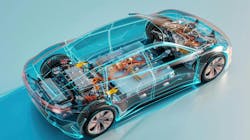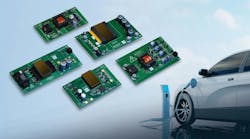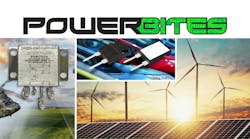Auto-Rated High-Withstand Voltage Detector Cuts Detect Time by Up to 92%
According to ABLIC, its S-19116 Series of automotive high-voltage detectors features the fastest detection response time of max. 6.8 μs—a reduction of up to 92%—when compared to conventional products. With an operation voltage range of 3.0 to 36.0 V and a voltage detection range of 8.0 to 24.0 V, the detector also achieves low current consumption of 2.0 μA typ.
Target applications include DC-DC converters, onboard chargers (OBCs), ADAS domain controllers, and battery-management systems (BMS). The detectors are housed in an ultra-compact HSNT-6 (1.96 × 2.46 × t0.5 mm) package, achieving an approximate 20% reduction in footprint than conventional products.
All devices undergo three-temperature tests (low temperature, normal temperature, and high temperature), with plans underway for compliance with the AEC-Q100 reliability and quality assessment requirements. PPAP (Production Part Approval Process) compliance is also planned.
Next in This Edition of PowerBites
More PowerBites
About the Author
Lee Goldberg
Contributing Editor
Lee Goldberg is a self-identified “Recovering Engineer,” Maker/Hacker, Green-Tech Maven, Aviator, Gadfly, and Geek Dad. He spent the first 18 years of his career helping design microprocessors, embedded systems, renewable energy applications, and the occasional interplanetary spacecraft. After trading his ‘scope and soldering iron for a keyboard and a second career as a tech journalist, he’s spent the next two decades at several print and online engineering publications.
Lee’s current focus is power electronics, especially the technologies involved with energy efficiency, energy management, and renewable energy. This dovetails with his coverage of sustainable technologies and various environmental and social issues within the engineering community that he began in 1996. Lee also covers 3D printers, open-source hardware, and other Maker/Hacker technologies.
Lee holds a BSEE in Electrical Engineering from Thomas Edison College, and participated in a colloquium on technology, society, and the environment at Goddard College’s Institute for Social Ecology. His book, “Green Electronics/Green Bottom Line - A Commonsense Guide To Environmentally Responsible Engineering and Management,” was published by Newnes Press.
Lee, his wife Catherine, and his daughter Anwyn currently reside in the outskirts of Princeton N.J., where they masquerade as a typical suburban family.
Lee also writes the regular PowerBites series.






